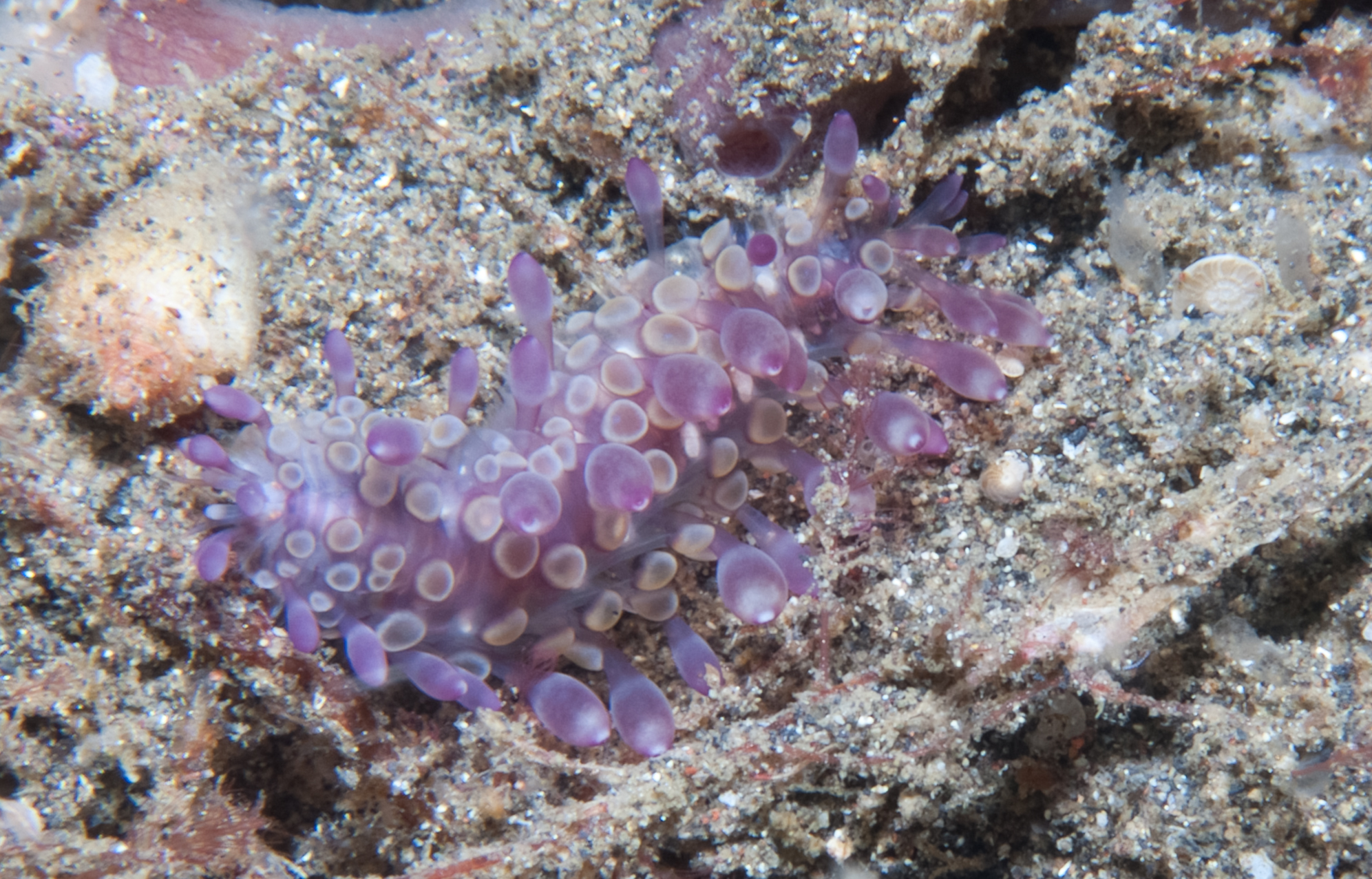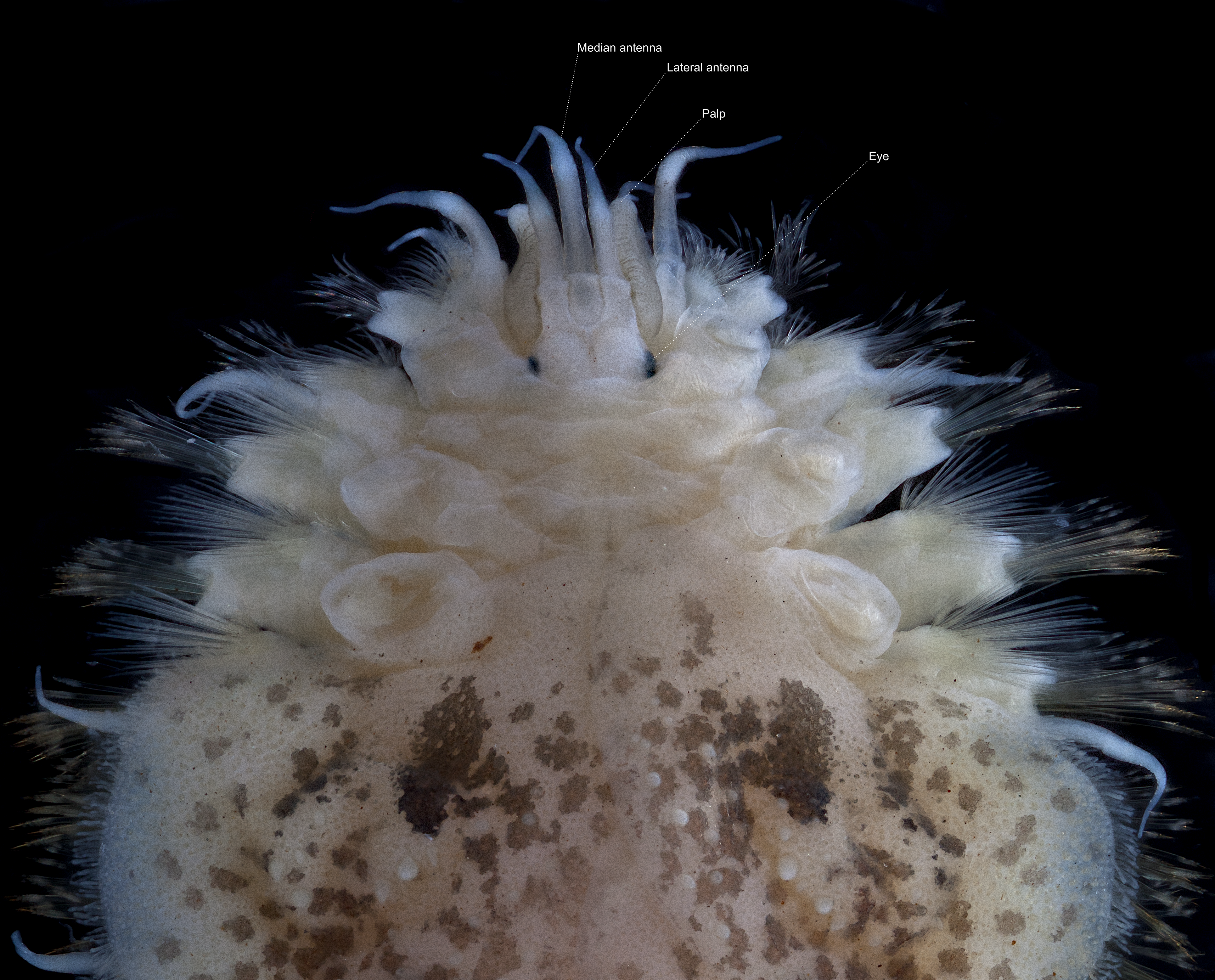|
Polyeunoa
''Polyeunoa'' is a genus of marine annelids in the family Polynoidae (scale worms). The genus contains two species, one from the Indian Ocean and the other widespread in the south-west Atlantic ocean and the Southern Ocean. Description Species of ''Polyeunoa'' are long-bodied with 70 or more segments and at least 15 pairs of elytra. The elytra leave part of the mid-dorsal body and most posterior segments uncovered. Cephalic peaks are absent or very small on the prostomium and the lateral antennae are inserted beneath the median antenna. The notochaetae are few and about as thick as the neurochaetae A chaeta or cheta (from Greek χαίτη “crest, mane, flowing hair"; plural: chaetae) is a chitinous bristle or seta found in annelid worms, (although the term is also frequently used to describe similar structures in other invertebrates such ..., which are numerous. Both unidentate and bidentate forms of chaetae are present.McIntosh, William C. s M'Intosh (1885). Report on th ... [...More Info...] [...Related Items...] OR: [Wikipedia] [Google] [Baidu] |
Polyeunoa Laevis
''Polyeunoa laevis'' is a scale worm which is widely distributed in the Southern Ocean and occurs over a wide depth range, from 35m to 2450m.Barnich R, Gambi C, Fiege D (2012) Revision of the genus Polyeunoa McIntosh, 1885 (Polychaeta, Polynoidae). Zootaxa 3523: 25–38. https://doi.org/10.11646/zootaxa.3523.1.3. Description ''Polyeunoa laevis'' has 75 segments, with 15 pairs of elytra. the dorsum is covered with numerous dark brown cross lines on every segment that are especially dense anteriorly. The lateral antennae inserted ventrally (beneath prostomium and median antenna). The notochaetae can be distinctly thicker than the neurochaetae, or about as thick as the neurochaetae, with bidentate neurochaetae absent. Taxonomic comments There is significant morphological and genetic diversity from different populations across ''P. laevis range and it is possible that further research will result in this taxon being divided into several species.Bogantes, V.E., Whelan, N.V., Webs ... [...More Info...] [...Related Items...] OR: [Wikipedia] [Google] [Baidu] |
Polyeunoa Maculata
''Polyeunoa maculata'' is a scale worm which is only known from Ratnagiri, IndiaDay JH (1973) Polychaeta collected by U.D. Gaikwad at Ratnagiri, south of Bombay. Journal of the Linnean Society of London, Zoology 52: 337–361. https://doi.org/10.1111/j.1096–3642.1973.tb01888.x Description ''Polyeunoa maculata'' has 53 segments, with 24 pairs of elytra. The dorsum is covered with three broken dark bands per segment, with a dark streak on top of the cirrophores, the base of which are pink. The lateral antennae inserted ventrally (beneath prostomium and median antenna). The notochaetae are thinner than the neurochaetae, with bidentate neurochaetae absent. Biology and ecology ''Polyeunoa maculata'' is commensal with another species of marine annelid, '' Mesochaetopterus japonicus''; it was first found inside the tube constructed by ''M. japonicus''. References {{Taxonbar, from=Q2079259 Phyllodocida ... [...More Info...] [...Related Items...] OR: [Wikipedia] [Google] [Baidu] |
Polynoidae
Polynoidae is a family of marine Polychaete worms known as "scale worms" due to the scale-like elytra on the dorsal surface. Almost 900 species are currently recognised belonging to 9 subfamilies and 167 genera. They are active hunters, but generally dwell in protected environments such as under stones. The group is widely distributed from shallow intertidal waters to hadal trenches. They are the most diverse group of polychaetes in terms of genus number and second most diverse in terms of species number which is almost 8% of all segmented worm species. Description Most Polynoidae species are short and flattened, but can reach as much as 20 cm in length and 10 cm width in '' Eulagisca gigantea'' and '' Eulagisca uschakovi''. Individuals are usually covered almost entirely by elytra, which can be shed and regenerated in many species. The elytra of some species are faintly bioluminescent, and leave glowing traces around the mouthparts of their predators, making those pre ... [...More Info...] [...Related Items...] OR: [Wikipedia] [Google] [Baidu] |
Annelids
The annelids (Annelida , from Latin ', "little ring"), also known as the segmented worms, are a large phylum, with over 22,000 extant species including ragworms, earthworms, and leeches. The species exist in and have adapted to various ecologies – some in marine environments as distinct as tidal zones and hydrothermal vents, others in fresh water, and yet others in moist terrestrial environments. The Annelids are bilaterally symmetrical, triploblastic, coelomate, invertebrate organisms. They also have parapodia for locomotion. Most textbooks still use the traditional division into polychaetes (almost all marine), oligochaetes (which include earthworms) and leech-like species. Cladistic research since 1997 has radically changed this scheme, viewing leeches as a sub-group of oligochaetes and oligochaetes as a sub-group of polychaetes. In addition, the Pogonophora, Echiura and Sipuncula, previously regarded as separate phyla, are now regarded as sub-groups of po ... [...More Info...] [...Related Items...] OR: [Wikipedia] [Google] [Baidu] |
Elytron (Annelida)
In annelids, elytra (; from Greek ἔλυτρον "sheath, cover"; singular: elytron ) are shield-like scales that are attached dorsally, one pair on each of a number of alternating segments and entirely or partly cover the dorsum. Elytra are modified dorsal cirri, and their number, size, location, and ornamentation are important taxonomic characters. The basal part of the elytra is known as the elytrophore; if (as is often the case) elytra are lost their presence is indicated by the elytrophore which is still present and visible. Annelids possessing elytra are also known as "scale worms". Possession of elytra is characteristic of the annelid suborder Aphroditiformia. Gallery File:Eunoe leiotentaculata lower res.jpg, A ''Eunoe leiotentaculata'' specimen showing its 15 pairs of elytra. File:Euphione sp. dorsal.jpg, ''Euphione ''Euphione'' is a genus of polychaetes belonging to the family Polynoidae. The species of this genus are found in Australia, Malesia Malesia is a ... [...More Info...] [...Related Items...] OR: [Wikipedia] [Google] [Baidu] |
Prostomium
The prostomium (From Ancient Greek, meaning "before the mouth"; plural: prostomia; sometimes also called the "acron") is the cephalized first body segment in an annelid worm's body at the anterior end. It is in front of (but does not include) the mouth, being usually a small shelf- or lip-like extension over the dorsal side of the mouth. The prostomium together with the peristomium, which includes the mouth and pharynx, make up the annelid head. Description The prostomium is part of the head and holds at least part of the brain and often bears sensory structures such as the eyes, antennae and palps. It may function like a kind of overlip when the animal is feeding. The prostomium bears many important taxonomic characters and its shape and composition are important for annelid systematics. In addition to the eyes, antennae and palps, the prostomium can possess appendages such as tentacles or cirri. Moreover, some polychaete Polychaeta () is a paraphyletic class of gener ... [...More Info...] [...Related Items...] OR: [Wikipedia] [Google] [Baidu] |
Chaeta
A chaeta or cheta (from Greek χαίτη “crest, mane, flowing hair"; plural: chaetae) is a chitinous bristle or seta found in annelid worms, (although the term is also frequently used to describe similar structures in other invertebrates such as arthropods). Polychaete annelids, ('polychaeta' literally meaning "many bristles") are named for their chaetae. In Polychaeta, chaetae are found as bundles on the parapodia, paired appendages on the side of the body. The chaetae are epidermal extracellular structures, and clearly visible in most polychaetes. They are probably the best studied structures in these animals. Use in taxonomy and identification The ultrastructure of chaetae is fundamentally similar for all taxa but there is vast diversity in chaetal morphology. Moreover, chaetae bear precise characters for determination of species and taxonomic assessment. The shape, absolute and relative size, number, position, ornamentation and type are important taxonomic characters ... [...More Info...] [...Related Items...] OR: [Wikipedia] [Google] [Baidu] |



